I appreciate it when visitors have good things to say about their Caribbean vacations. After all, the livelihood of my people depends on tourists regaling other with their stories.
But I resent it when tourists presume they know how beautiful my country is after spending a few days there lounging on a beach at some all-inclusive (invariably foreign-owned) resort. After all, life at a resort reflects the daily lives of islanders about as much as life on Mars reflects the daily lives of earthlings.
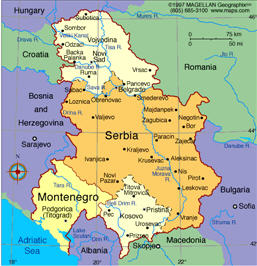 It is in this spirit of enlightened ignorance that I share the following story of my Serbian vacation. Never mind that I traveled there knowing far more about this country than most tourists ever seem even interested in knowing about my country, The Bahamas.
It is in this spirit of enlightened ignorance that I share the following story of my Serbian vacation. Never mind that I traveled there knowing far more about this country than most tourists ever seem even interested in knowing about my country, The Bahamas.
Serbia, of course, is all that remains of the former Yugoslavia: a polyglot of ethnic groups that were marshaled into a Balkan state by Western powers after World War I. But since this story is about my vacation, I shall venture no further into the history of Yugoslavia or the internecine conflicts that led inexorably to its implosion into several independent states. (However, I invite you to read the Related Articles below for a little of my thoughts on some of the issues that continue to bedevil Serbia’s national identity and economic development.)
I am always incredulous of stories by well-traveled tourists who claim to have experienced foreign countries “like the locals do.” Because the only way this is remotely possible is to have a trusted friend – who is a native of the country in question – serve as one’s host and personal tour guide.
This is why I am so grateful to my friend of over 20 years for inviting me into her home in the Serbian capital of Belgrade, taking me to so many interesting sights, and sharing so many local insights (gossip about Srpska posla) during my five-day visit.
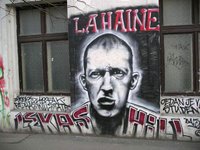 On our scenic drive from the Airport, my eyes were drawn to what appeared to be Soviet-era buildings that have become eyesores – as much from decades of poor maintenance and disrepair as from the ravages of war (including the US bombs that destroyed a few of them in 1999). But I was also struck by the prevalence of graffiti defacing so many structures, which prompted me to remark that Belgrade must have imported the graffiti that seemed to disappear from New York City overnight many years ago.
On our scenic drive from the Airport, my eyes were drawn to what appeared to be Soviet-era buildings that have become eyesores – as much from decades of poor maintenance and disrepair as from the ravages of war (including the US bombs that destroyed a few of them in 1999). But I was also struck by the prevalence of graffiti defacing so many structures, which prompted me to remark that Belgrade must have imported the graffiti that seemed to disappear from New York City overnight many years ago.
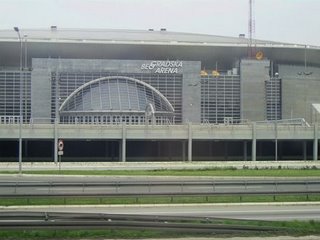 Nevertheless, there were signs of urban renewal. And nothing symbolized this more than the Beogradska Arena – a decidedly post-Soviet complex (opened in 2004) with a seating capacity of over 20,000 that was designed to feature everything from sports events (especially basketball) to cultural programs (like the rap concert 50 Cent performed there in November 2006).
Nevertheless, there were signs of urban renewal. And nothing symbolized this more than the Beogradska Arena – a decidedly post-Soviet complex (opened in 2004) with a seating capacity of over 20,000 that was designed to feature everything from sports events (especially basketball) to cultural programs (like the rap concert 50 Cent performed there in November 2006).
My questions about Belgrade’s beleaguered buildings and crumbling infrastructure soon prompted my host to disabuse me of any expectation that tours of Belgrade’s architecture would be the highlight of my visit. Not that I had an abiding interest in or possess the academic training to assess the architectural merit of these buildings. In fact, my questions merely reflected my informed concerns about Serbia’s enduring geopolitical and economic malaise.
Sure enough, as we sauntered about on our daily walking tours, I was pleasantly surprised by the vibrancy of city life in Belgrade. It projects the surreal character of a bustling city struggling against itself to avoid devolving back into a sprawling village. Indeed, except for evidence of its urban decay and no sighting of a solitary black face amongst the teeming masses (more about that later), we could easily have been walking along the streets of London or Paris.
Incidentally, given that Belgrade is hardly known as a favorite tourist destination, I was constrained to wonder whether Serbs spend more of their weekdays sitting in street-side cafes than working …
At any rate, our walks pass Belgrade Palace, the monumental main post office, Hotel Moskow, City Hall, the Houses of Parliament, the National Theatre, other landmarks to Terazije street, and down to Kalemegdan were not without some architectural highlights. But Kalemegdan – Serbia’s largest municipal park – was a sight to behold … and experience.
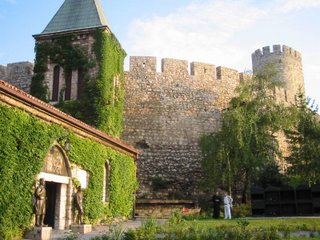 This park grew out of a military fortress, which dates to the 3rd Century and was reinforced and relied upon throughout its history by Serb oppressors (including the Romans, Hungarians and Turks) to keep foreign enemies and preternaturally pugnacious Serbs at bay. It features “artillery structures, medieval fortification with its ramparts, gateways, barbicans and the excavated ruins of a castle, the Roman remains”.
This park grew out of a military fortress, which dates to the 3rd Century and was reinforced and relied upon throughout its history by Serb oppressors (including the Romans, Hungarians and Turks) to keep foreign enemies and preternaturally pugnacious Serbs at bay. It features “artillery structures, medieval fortification with its ramparts, gateways, barbicans and the excavated ruins of a castle, the Roman remains”.
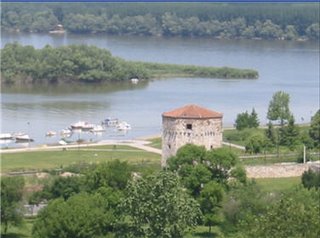 These and other man-made attractions abounded, including the quaint little Church of Sv. Petka where a couple very dear to me got married in 1946. Yet the highlight of Kalemegdan was looking down from our fortress promontory onto the natural wonder (i.e. the confluence) “where the Sava river gives itself to the Danube.”
These and other man-made attractions abounded, including the quaint little Church of Sv. Petka where a couple very dear to me got married in 1946. Yet the highlight of Kalemegdan was looking down from our fortress promontory onto the natural wonder (i.e. the confluence) “where the Sava river gives itself to the Danube.”
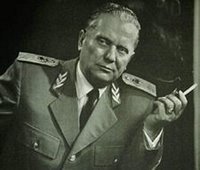 Alas, I suspect I may have betrayed my overzealous interest in the tortured political history of Serbia by lobbying my host to take me to Dedinje to visit the shrine of Joseph Broz Tito. From 1953 until his death in 1980, he commanded solidarity and allegiance among the fractious peoples of the Balkans to the amorphous state of Yugoslavia.
Alas, I suspect I may have betrayed my overzealous interest in the tortured political history of Serbia by lobbying my host to take me to Dedinje to visit the shrine of Joseph Broz Tito. From 1953 until his death in 1980, he commanded solidarity and allegiance among the fractious peoples of the Balkans to the amorphous state of Yugoslavia.
Of course, my interest in Tito stems from the fact that he played the role as a pawn in the Cold War (geopolitical) chess game between the Soviet Union and the United States with more élan and self-determination than any other Third-World leader. But I suppose it’s a reflection of the resentful or ambivalent regard many Serbs have for him that his shrine looks more suitable as a resting place for a gypsy patriarch than a memorial to the most influential leader of the former Yugoslavia.
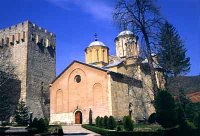
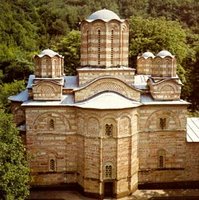 We spent the final day of my trip in the Serbian countryside visiting the monasteries of Koporni, Ravanica, and Manasija. I’ve already admitted that I don’t have much interest in architecture. And regular readers know well of my religious apostasy (or iconoclasm). Therefore, I fully appreciate how this going to the chapel might seem a little hypocritical. But surely only an oaf would go to Paris and fail to visit Notre Dame, no?
We spent the final day of my trip in the Serbian countryside visiting the monasteries of Koporni, Ravanica, and Manasija. I’ve already admitted that I don’t have much interest in architecture. And regular readers know well of my religious apostasy (or iconoclasm). Therefore, I fully appreciate how this going to the chapel might seem a little hypocritical. But surely only an oaf would go to Paris and fail to visit Notre Dame, no?
At any rate, it just so happened that as we were ending our tour of Ravanica, several school buses filled with students from local villages pulled up for guided tours. I gathered such tours are as much a rite of passage for Serbs as pilgrimages to Mecca are for Saudis. But it was here that my acute sense of being a black man in Serbia was thrown into stark relief.
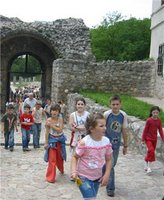 I got many curious stares from people in the streets of Belgrade. But no one ever said a word to me. But there was something so endearing in the stares every one of the students who passed us by on their way into the monastery. And, just as my host was interpreting their not-so-subtle whispers (“wow, there’s a black man”), a statuesque young girl, about age 12, approached us. In perfect English, she asked my host (strangely enough) if it would be okay to take a picture with me. I was happy to oblige.
I got many curious stares from people in the streets of Belgrade. But no one ever said a word to me. But there was something so endearing in the stares every one of the students who passed us by on their way into the monastery. And, just as my host was interpreting their not-so-subtle whispers (“wow, there’s a black man”), a statuesque young girl, about age 12, approached us. In perfect English, she asked my host (strangely enough) if it would be okay to take a picture with me. I was happy to oblige.
But soon others followed, including some curious enough to ask to touch my hair and skin. I obliged.
(In all of my interactions – with Serbs who served me in restaurants to those who fielded my queries at tourist sites – they were exceedingly friendly!)
Truth be told, though, the most memorable part of my trip was spent indoors chatting expansively over lavish meals at the homes of local Serbs – as we did for hours every day. Indeed, I could not help thinking that whatever Serbs lack in material comfort – by admittedly ostentatious American standards – they fully compensate for with good company, good food, and stimulating conversation to almost bacchanalian excess.
My only regret is that the few phrases I managed to mumble in Serbian provided little more than comic relief for these multi-lingual folks whose command of English would make most of my American friends blush with envy. But after this brief visit, I feel comfortable declaring that:
Ja se ponosim sto sam pocasni crni Srbin
Related Articles:
Kosovo: wither Serbia’s Alamo…
Death of Milosevic…
Serbs fail (once again0 to honor promise to turn over war criminals…
Serbian war criminals hiding in plain sight…
Belgrade, Serbia
Leave a Reply
You must be logged in to post a comment.